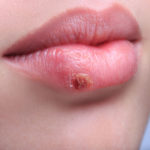What NOT to Do When a Cold Sore is Brewing

Despite its common name, a “cold sore” doesn’t need its host to be saddled with the common cold in order to suddenly appear on their lip. Its other misleading name is “fever blister.” Likewise, its host doesn’t need to have a fever in order for it to pop up. The environment it does seem to love is a worn out host whose immune system has been weakened by stress, fatigue, hormonal changes, or the presence of another viral attack. Cold sores can even be triggered by hot sun or cold wind exposure.
These painful, fluid-filled blister clusters are most typically an outbreak of the herpes simplex virus (HSV-1), not to be confused with the sexually transmitted blisters caused by the herpes simplex virus HSV-2.
While there is no known cure for cold sores, there are steps you can take to quicken their healing and lessen their severity. The best over-the-counter attack for cold sores is the product, Abreva®, which, as its name alludes to, abbreviates the tingly pain and temporary disfigurement of cold sores.
Recently I learned there are dietary no-no’s to avoid, which, if ignored, can most definitely have the opposite effect, lengthening the duration and increasing the severity of the blisters. The thing these foods have in common is that they are rich in arginine while at the same time being low in lysine, two different essential* amino acids.
Here’s a short list of foods to steer clear of the moment that telltale lip tingling begins:
- Nuts, especially almonds and peanuts
- Pumpkin seeds
- Chocolate
- Oat and wheat grains
- Squash
*Essential amino acids cannot be produced within the body. They must be provided by dietary intake.